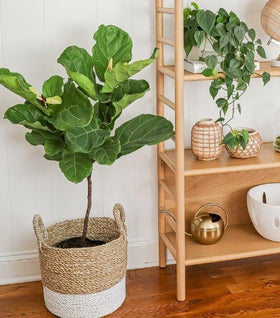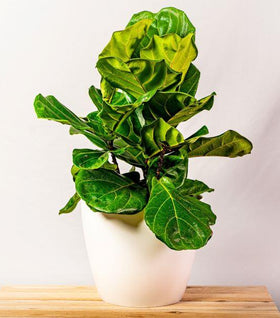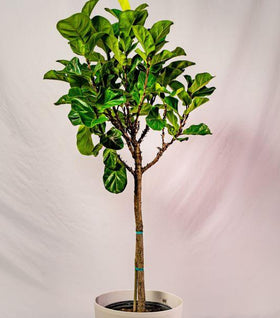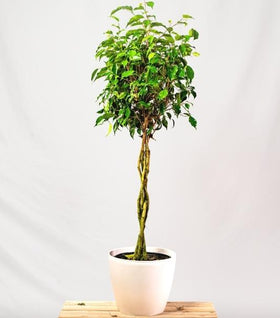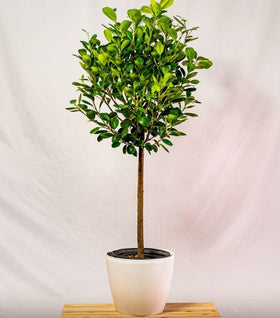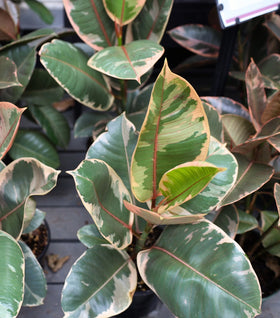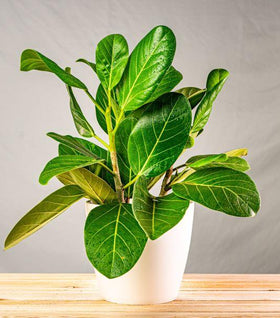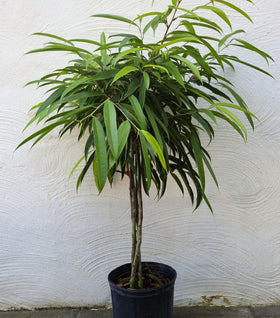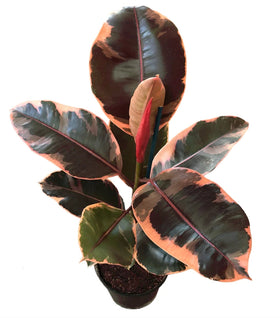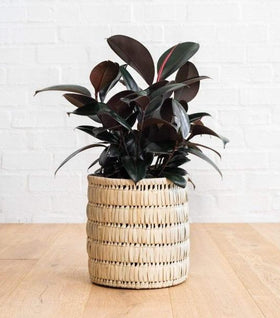Ficus Trees for Sale Online
Ficus Trees are also called fig trees. They are among the most popular indoor trees grown today, and there are many good reasons for that. Ficus trees are easy to grow indoor plants and offer a lot of variety, from the long-leaved ficus trees to the very large-leaved Fiddle Leaf Figs. Most ficus trees have green leaves but occasionally there are variegated leaves as in the case of Variegated benjamina Ficus tree or the very popular Ficus altisssima 'Golden Gem'.
Types of Ficus Trees
Fiddle Leaf Figs or Ficus lyrata: The Fiddle Leaf Fig has become one of the most popular houseplants of all time. This is largely due to the massive dark green leaves. This tough plant adapts easily to conditions and once acclimated it can grow to 6 feet tall or taller. These are available in either Tree Form or Bush Form.
Little Leaved Fiddle Leaf Fig or Little Fiddle: Not everyone has room for a large fiddle leaf fig tree. If you're one of those people this is the tree for you. It stays more compact than its cousin and won't take up valuable space in your home or apartment.
Ficus Alii or Long Leaved Ficus: Ficus Alii is an elegant houseplant grown as a tree with long graceful shiny green leaves. The trunk of these trees is braided which gives the plant an added dimension of interest.
Ficus benjamina trees or Weeping Fig Tree: Weeping figs are perhaps the most popular indoor tree of the family. their shiny leaves and gracefully arching branches give the tree a delicate, elegant appearance that can be matched to any decor. Weeping Fig Trees are offered a braided style, a single stem tree form, bush form, and are even available in a variegated leaf form.
Ficus Altissima Golden Gem: The large leaves on the Ficus altissima Golden Gem is a little like its cousin the rubber plant and has wonderfully pale green veins that show up beautifully against the emerald green and yellow of the leaf.
Ficus Moclame: Also known as the Laurel Fig, this ficus is similar to the Ficus Benjamin, the Moclame has thicker, rounded leaves and has proven to be one of the easiest to grow Fig Trees.
Ficus Audrey: This plant is an up-and-coming star in the world of Ficus. Ficus benghalensis or Audrey ficus is been called "the next fiddle leaf fig" by many plant influencers. It's easy to grow and very forgiving of less than perfect growing conditions.
Ficus Ginseng: Ficus Ginseng is an excellent choice for bonsai tree growers or those who want the look of a bonsai tree without the constant upkeep. Ficus Ginseng is characterized by the shape of its strong roots and stems and small, alternating oval dark green leaves that grow up the stem.
Rubber Trees or Ficus elastica for sale:
The rubber plant or Rubber Tree family is all about having an easy-to-grow small tree indoors. With their broad shiny attractive leaves and ease of care, this is one type of indoor tree anyone can grow. When this plant is small it's well suited as a centerpiece on a table, shelf, or windowsill. Once it begins to grow above 3-4 ft they look great standing next to a fireplace or near door entrances
Burgundy Rubber Tree: The Burgundy Ficus or Burgundy Rubber Plant has large oval-shaped leaves that are a rich chocolate burgundy-brown color.
Ficus Ruby: The Ficus Ruby plant has large oval-shaped leaves that are outlined with strawberry-cream colored margins color. In terms of care, Ficus Ruby is a very easy house plant to grow.
Ficus Tineke: Harder to say than grow. Tineke Rubber Plant has gorgeous bright red variegation that is present only on the newer leaves. Leaves gradually mature to a cream & green color.
Growing a Ficus Tree
Read our planting guide on How to Care for Your Fiddle Leaf Fig.
While ficus trees are relatively easy to grow, they do have some special needs you'll need to consider. Here are some things to keep in mind when considering growing a ficus tree as a houseplant.
Light: Ficus trees love bright, indirect light and lots of it. Your plant will enjoy spending time outside during the summer months, but protect the plant from direct sunlight until it's acclimated to the full sun. This involves slowly over the course of a few weeks giving the tree more and more direct sun daily.
During winter, keep your plant away from cold drafts and don't allow it to stay in a room that falls below 60 degrees F. Most Ficus will make great patio plants so don't be afraid to take it outside.
Water: Ficus trees prefer consistent watering throughout the growing season. Dry spells in the winter are perfectly acceptable. Make sure the soil is just moist at all times but be sure to cut back the frequency of watering in the winter.
Your ficus tree will likely lose a few leaves during the winter "dry" spell and it never hurts to mist the tree at any time of the year. Misting the leaves can provide additional moisture during dry spells, with less threat of root rot.
Soil: Well-draining soil is essential to keeping your ficus healthy. Ocean Forest Potting soil is our go-to soil for Ficus trees of all kinds.
Fertilizer: Fertilize ficus trees during the active growth period in summer. You will see bright new leaves appear during this time. Use a quality water-soluble fertilizer diluted to half strength and fertilize every three or four weeks until the active growth period ends.
We recommend Jack's Classic all-purpose fertilizer. Jack's Classic is a balanced fertilizer that is suited to the needs of ficus plants. There is no need for fertilizer during the winter months.
Pruning: Prune your ficus in late winter or early spring before new growth appears. Make cuts on branches just above a leaf node. New growth will appear from below the cut. Prune out dead branches any time throughout the year. The yearly pruning of certain ficus plants can help build a fuller canopy.
Leaf Dropping on Ficus benjamina:
Ficus benjamina Leaf Drop: Ficus benjamina plants are sensitive to changes in their environment. They react to these changes by dropping leaves. The leaves turn yellow and fall off. If you have just moved your ficus tree to a new location, expect leaf drop.
This also occasionally happens after your new plant arrives. The leaves will grow back when the plant adjusts. When and if this happens, reduce the frequency of watering until the tree begins producing new leaves.
If your tree has not been moved, it may be reacting to a change in lighting conditions which happens occasionally as the seasons change. Ficus become set in their ways so be aware of the ficus' regular habits and try not to deviate from them to avoid leaf drop.
The sap of ficus trees is mildly toxic to pets and humans if the leaves are ingested.
If you’re looking to purchase a Ficus Plant for your home or office interior, consider Woodie’s Approved collection of Ficus Plants from Garden Goods Direct. As America’s number one online garden center, we offer a broad selection of houseplants and indoor trees including many types of Ficus. We also offer advice from our helpful and friendly customer service plant experts that you may need to keep your plants healthy.
From Aglaonema to ZZ Plants, we have a vast range of house plants, all available from our online store. Buy your Ficus plant online from Garden Goods Direct today! We care about the condition that your plant arrived.

